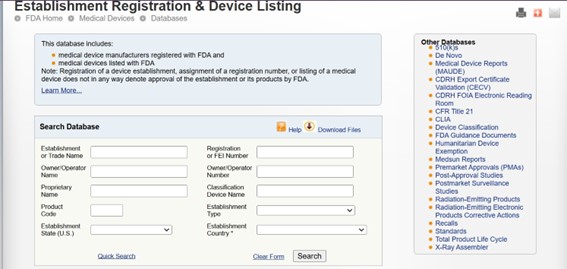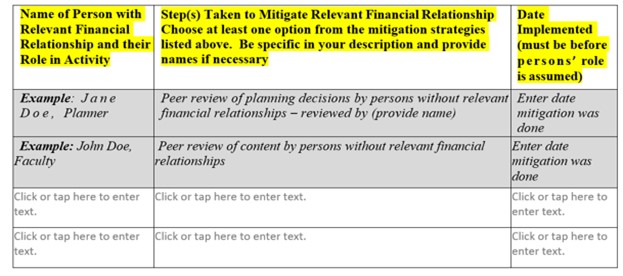How to Manage Financial Relationships in Continuing Education Activities
To maintain a learning environment free from industry bias and to ensure that all content is evidence-based, we need to identify and appropriately manage financial relationships with certain companies. This ensures transparency and fairness
The person (the Reviewer) mitigating a disclosure should:
- Not have any financial relationships within ineligible companies.
- Should be a planning committee member of the educational activity.
- Review and mitigate, if necessary, every financial relationship disclosed by the individual (planning or faculty member)
Key Steps to Address Financial Relationships
1. Identify financial relationships
Review all financial relationship(s), within the last 24 months of anyone in control of content. You are looking for all relationships with an ineligible company.
Definition: An ineligible company is an entity whose primary business is producing, marketing, selling, reselling or distributing healthcare products used by or on patients. Another term for ineligible is commercial.
Examples include:
- Advertising, marketing or communication firms whose clients are ineligible companies
- Bio-medical startups that have begun a governmental regulatory approval process.
- Compounding pharmacies that manufacture proprietary compounds
- Device manufacturers or distributors
- Diagnostic labs that sell proprietary products
- Growers, distributors, manufacturers or sellers of medical foods and supplements
- Pharmaceutical companies or distributors
- Pharmacy benefit managers
- Reagent manufacturers or sellers
All financial relationships regardless of the amount should be disclosed including the:
- Name of the company
- Role/Nature of the relationship (i.e., employee, contractor, royalties, advisor, consultant, etc.)
2. Owner/employee relationships:
- Is the individual an owner or employee of any ineligible company?
3. Privately held Stock
- Does this person own any privately held stock? Privately held stock is stock from a company that is not traded on the stock exchange, usually a start-up company.
4. Government Regulatory Process
- If the person owns private stock, check to see if the company has started the government regulatory process for any of their products. To do this please visit, Establishment Registration & Device Listing
- Here you can search to see if the company has entered the regulatory process.

5. Diagnostic/Therapeutic Options
- Will diagnostic and/or therapeutic options be presented or discussed in the educational activity?
6. Determine Relevance
- Determine if any of the financial relationship(s) are relevant to the content.
CME content does not have to explicitly mention or promote the business lines or products of an ineligible company for there to be an opportunity for commercial bias. Financial relationships are relevant if the educational content an individual can control is related to the business lines or products of the ineligible company.
It is insufficient to simply refrain from discussing the specific product or service of the company. Ask yourself, is there an opportunity to insert bias towards the company(ies) disclosed/and its products.
For example, if the educational content is about Treating 4 Common Types of Cardiovascular Disease, and the speaker disclosed a financial relationship (as a consultant) with Pfizer, then the content does relate to the business lines of the eligible company (Pfizer).
7. Determine which financial relationships need to be mitigated
- A financial relationship, in any amount, exists between the person in control of content and an ineligible company.
- The financial relationship has existed during the past 24 months. Select even if the relationship has ended.
- The content of the education is related to the products of an ineligible company with whom the person has a financial relationship.
8. Choose a mitigation strategy
If you selected any of the boxes above, we must mitigate the relationship. Using the list below, choose a mitigation strategy(ies). This must be done, before the person assumes their role.

9. Documenting the Mitigation Strategy
It is very important to document all the mitigation strategies that were used for relevant financial relationships. Make sure to be specific in your documentation.
In the first column, provide the name of the person who has disclosed the financial relationship and their role in the activity (i.e., planner, faculty, reviewer, consultant speaker, etc.)
The second column should document the steps taken to mitigate the relevant financial relationship. Remember, the name(s) of the individual(s) who are conducting the disclosure review must be included.

Download here: How to Mitigate a Disclosure
